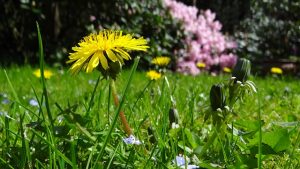As summer turns into autumn, which inevitably turns to winter, you’ll notice many plants beginning to lock up shop and hibernate. The coming cold represents a huge challenge to plants, with many of the more temperate areas of Australia experiencing minimal sun and frosty conditions over winter.
For most Australians their lawn will be one of the plants challenged during this period. Australia, relative to many other places, is quite a warm country. For that reason we tend to plant warm season grasses rather than the cool season varieties so popular in Europe and North America. By and large warm season varieties are fantastic at dealing with the drought and the heat of the Australian summer, but this hardiness in heat is countered by a susceptibility to the cold.
Warm season grasses tend to go into hibernation mode as autumn wears on, which can result in a lawn that may not be dead, but can certainly look bare and brown. In order to keep your lawn as beautiful as possible it’s important to maintain the grass properly over autumn. Solid autumnal maintenance will also ensure that your turf is as strong as possible as winter approaches, as a healthy warm season grass will fare far better through this cold time of the year.
So what does a good autumn maintenance routine look like for an Australian lawn owner? Let’s take a look.
A Regular Mow
The start of autumn can actually be one of the quickest growing periods for a warm season lawn, as the temperature becomes milder, the rain becomes more abundant but the soil remains warm. Regular mowing is essential, and you should be careful to take off no more than a third of the blade at a time, lest you stress the grass out. Ensure your blades are sharp, as a dull blade will serve to tear at the grass rather than slice through it, causing the lawn to brown.
Removing the Debris
When you picture autumn in your mind, you inevitably think of falling leaves in a rainbow of earthy colours. It’s a beautiful sight, but a build-up of these leaves can actually cause your lawn damage. They can suffocate the grass, prevent the blades from photosynthesising, and can provide the perfect conditions for fungus to thrive. If you don’t feel like raking, be sure to use the catcher on your mower when you cut the grass back.
Food and Drink
Depending on whether your area has a wet autumn or a dry one, you’ll need to ensure that your lawn gets enough moisture in the lead up to winter, and this could mean irrigating. If you’re experiencing a dry autumn then aim to give your grass a deep soak twice a week.
Autumn is also a great time to fertilise. It’ll promote strong root growth, allowing your lawn to extend its reach deep into the soil and tap into nutrients that’ll keep it going through the winter. Use a nitrogen-heavy slow release fertiliser.
Patch Up Bald Spots
The milder conditions but warmer soil make autumn a great time to reseed any bare patches that summer has inflicted on your lawn. Be sure to sow at the start of autumn, however, to ensure that your seeds will have long enough to establish before the weather turns.
Let It Breathe
Aeration is one of the most underrated acts of garden maintenance. It’s as simple as making holes in your lawn’s soil to allow oxygen, moisture and nutrients to get to the roots; a quick and easy job that can have a huge impact on the health of your lawn, particularly if it’s been planted in clay-based or compacted soil. Use either a garden fork or a purpose-built aerator for the job.
Weeds and Insects
Broadleaf weeds love the colder conditions, and are a real danger during autumn. Likewise, grubs, beetles and other insects will enjoy the mildness of the season and can take over your turf in a matter of days. Be sure to check for signs of either throughout autumn, and act quickly with a herbicide or pesticide if potential problems are found.
For any other autumn lawn maintenance tips, contact the friendly team at McKays.


